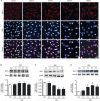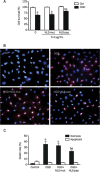Nuclear translocation of cysteinyl leukotriene receptor 1 is involved in oxygen-glucose deprivation-induced damage to endothelial cells
- PMID: 23085741
- PMCID: PMC4001833
- DOI: 10.1038/aps.2012.101
Nuclear translocation of cysteinyl leukotriene receptor 1 is involved in oxygen-glucose deprivation-induced damage to endothelial cells
Abstract
Aim: Cysteinyl leukotriene receptor 1 (CysLT(1) receptor) is located in epithelial cells, and translocates from the plasma membrane to the nucleus in a ligand-dependent manner. Here, we investigated whether CysLT(1) receptors translocated to the nucleus in endothelial cells after ischemic insult in vitro and whether it was involved in ischemic injury to endothelial cells.
Methods: EA.hy926 cell line, derived from human umbilical vein endothelial cells, was subjected to oxygen-glucose deprivation (OGD). The expression and distribution of CysLT(1) receptors were detected by immunofluorescent staining, immunogold labeling and immunoblotting analyses. Cell viability was evaluated using MTT reduction assay. Necrosis and apoptosis were determined by double fluorescent staining with propidium iodide and Hoechst 33342.
Results: CysLT(1) receptors were primarily distributed in the cytoplasm and nucleus in EA.hy926 cells, and few was found in the cell membrane. OGD induced the translocation of CysLT(1) receptors from the cytoplasm to the nucleus in a time-depen dent manner, with a peak reached at 6 h. OGD-induced nuclear translocation of CysLT(1) receptors was inhibited by pretreatment with the CysLT(1) receptor antagonist pranlukast (10 μmol/L), or by preincubation with NLS-pep, a peptide corresponding to the nuclear localization sequence of CysLT(1) receptor (10 μg/mL). However, zileuton, an inhibitor of 5-lipoxygenase that was a key enzyme in cysteinyl leukotriene generation, did not inhibit the nuclear translocation of CysLT(1) receptors. Moreover, preincubation with NLS-pep (0.4 μg/mL) significantly ameliorated OGD-induced cell viability reduction and necrosis.
Conclusion: CysLT(1) receptors in endothelial cells translocate to the nucleus in a ligand-independent manner after ischemic insult in vitro, and it is involved in the ischemic injury.
Figures





Similar articles
-
Pranlukast attenuates ischemia-like injury in endothelial cells via inhibiting reactive oxygen species production and nuclear factor-kappaB activation.J Cardiovasc Pharmacol. 2009 Jan;53(1):77-85. doi: 10.1097/FJC.0b013e318196736c. J Cardiovasc Pharmacol. 2009. PMID: 19129732
-
[5-Lipoxygenase/cysteinyl leukotriene pathway is not involved in injury of rat C6 glioma cells induced by oxygen-glucose deprivation].Zhejiang Da Xue Xue Bao Yi Xue Ban. 2008 Sep;37(5):456-62. doi: 10.3785/j.issn.1008-9292.2008.05.006. Zhejiang Da Xue Xue Bao Yi Xue Ban. 2008. PMID: 18925711 Chinese.
-
Activation of CysLT receptors induces astrocyte proliferation and death after oxygen-glucose deprivation.Glia. 2008 Jan 1;56(1):27-37. doi: 10.1002/glia.20588. Glia. 2008. PMID: 17910051
-
[Research advance in cysteinyl leukotriene receptors with brain injury].Zhejiang Da Xue Xue Bao Yi Xue Ban. 2008 May;37(3):315-20. doi: 10.3785/j.issn.1008-9292.2008.03.018. Zhejiang Da Xue Xue Bao Yi Xue Ban. 2008. PMID: 18546539 Review. Chinese.
-
[Leukotriene modifiers].Nihon Rinsho. 2001 Oct;59(10):1979-85. Nihon Rinsho. 2001. PMID: 11676142 Review. Japanese.
Cited by
-
Copper-catalyzed C2-selective alkynylation of chromones via 1,4-conjugate addition.Mol Divers. 2024 Feb;28(1):125-131. doi: 10.1007/s11030-023-10625-7. Epub 2023 Mar 7. Mol Divers. 2024. PMID: 36881209
-
Cysteinyl leukotrienes regulate endothelial cell inflammatory and proliferative signals through CysLT₂ and CysLT₁ receptors.Sci Rep. 2013 Nov 20;3:3274. doi: 10.1038/srep03274. Sci Rep. 2013. PMID: 24253666 Free PMC article.
References
-
- Singh RK, Gupta S, Dastidar S, Ray A. Cysteinyl leukotrienes and their receptors: molecular and functional characteristics. Pharmacology. 2010;85:336–49. - PubMed
-
- Capra V, Thompson MD, Sala A, Cole DE, Folco G, Rovati GE. Cysteinyl-leukotrienes and their receptors in asthma and other inflammatory diseases: critical update and emerging trends. Med Res Rev. 2007;27:469–527. - PubMed
-
- Nielsen CK, Campbell JI, Ohd JF, Morgelin M, Riesbeck K, Landberg G, et al. A novel localization of the G-protein-coupled CysLT1 receptor in the nucleus of colorectal adenocarcinoma cells. Cancer Res. 2005;65:732–42. - PubMed
-
- Fang SH, Wei EQ, Zhou Y, Wang ML, Zhang WP, Yu GL, et al. Increased expression of cysteinyl leukotriene receptor-1 in the brain mediates neuronal damage and astrogliosis after focal cerebral ischemia in rats. Neuroscience. 2006;140:969–79. - PubMed
Publication types
MeSH terms
Substances
LinkOut - more resources
Full Text Sources
Miscellaneous

